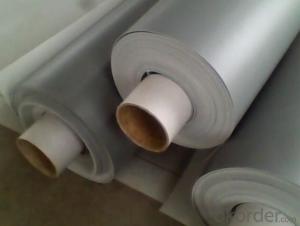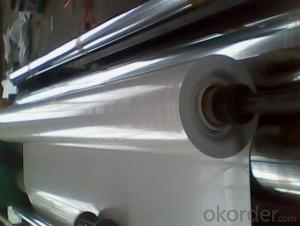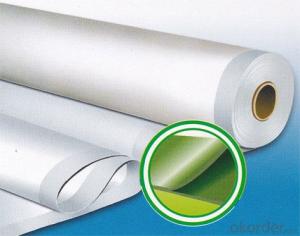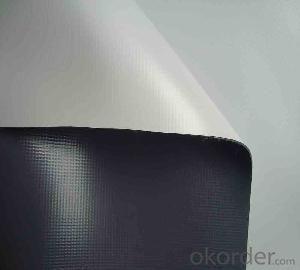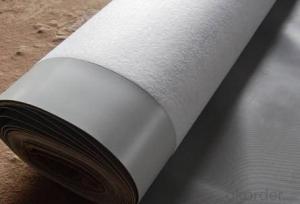PVC Waterproof Membrane in 0.6mm Thickness and Low Price
- Loading Port:
- Shanghai
- Payment Terms:
- TT OR LC
- Min Order Qty:
- 20000 m²
- Supply Capability:
- 5000000 m²/month
OKorder Service Pledge
OKorder Financial Service
You Might Also Like
PVC Waterproof Membrane in 0.6mm Thickness
Product Description of PVC Waterproof Membrane in 0.6mm Thickness:
PVC Membrane Waterproof /Waterproofing membrane For Roof is a new polymer waterproof membrane. The PVC Membrane Waterproof /Waterproofing membrane For Roof raw material is polyvinyl chloride resin, mixed with plasticizer, filler, antioxygen, ultraviolet absorber and other auxiliaries.
Thickness: 1.2mm/1.5mm/1.8mm/2.0mm
Width:2050mm
Length:20m( Special specifications can be customized)
Size: 2.05mx20m
Color: white/grey, or any other colors.
Features of PVC Waterproof Membrane in 0.6mm Thickness:
1. Excellent aging resistance. Service life of roofing material is over 20 years; service life of underground material is over 50 years.
2. Root resistant penetration, specially used on planting roofings.
3. Welding installation. Joints are solid and environment friendly, no pollution.
4. High tensile strength, good elongation and dimensional stability.
5. Good plasticity, easy and suitable for details installation.
6. Fireproof. Fire extinguished out of the ignition resource.
7. Surface is smooth, no fading and dirty resistant.
8. Width is over 2m. Construction wastage is small, more economical.
Classification of PVC Waterproof Membrane in 0.6mm Thickness:
1. N: Homogeneous PVC membrane
2. L: PVC membrane with fabric backing
3. W: Reinforced PVC membrane
Advantage of PVC Waterproof Membrane in 0.6mm Thickness:
1.) Mixing automation. Apply automatic temperature control automatic time control and automatic feed control.
2.) Extrusion equipment uses twin screw coextrusion. Screw temperature uses computer automatic temperature control system.
3.) Handpiece uses large width didhead extrusion equipment.
4.) Sophisticated three-roller calender equipment. The space between equiment is controlled by automation system.
Technical Data of PVC Waterproof Membrane in 0.6mm Thickness:
No. | Item | Model Ⅱ | |
1 | Tensile Strength Mpa ≥ | 12.0 | |
2 | Elongation at break% ≥ | 250 | |
3 | Shrinkage rate % ≤ | 2.0 | |
4 | Flexibility at low temperature | No crackle at -25oC | |
5 | Water tightness | Watertight | |
6 | Puncture resistance | Watertight | |
7 | Heat aging treatment | Appearance | Free from bubble, crack, cohesion and void |
Change rate of tensile strength % | +20oC | ||
Change rate of elongation at break | |||
Flexibility at low temperature | No crack at -20oC | ||
8 | Chemical corrosion resistance | Change rate of tensile strength % | +20 |
Change rate of elongation at break | |||
Flexibility at low temperature | No crack at -20oC | ||
9 | Artificial weathering | Change rate of tensile strength % | +20 |
Change rate of elongation at break | |||
Flexibility at low temperature | No crack at -20oC | ||
Application of PVC Waterproof Membrane in 0.6mm Thickness:
PVC waterproof membrane forms an effective barrier to liquid water or water vapor in the steel structure for industrial and civil engineering, underground engineering, such as subway, bridges , tunnel, water pools, shelter, grain depot, land filling and subwayProducts display.
Images of PVC Waterproof Membrane in 0.6mm Thickness:

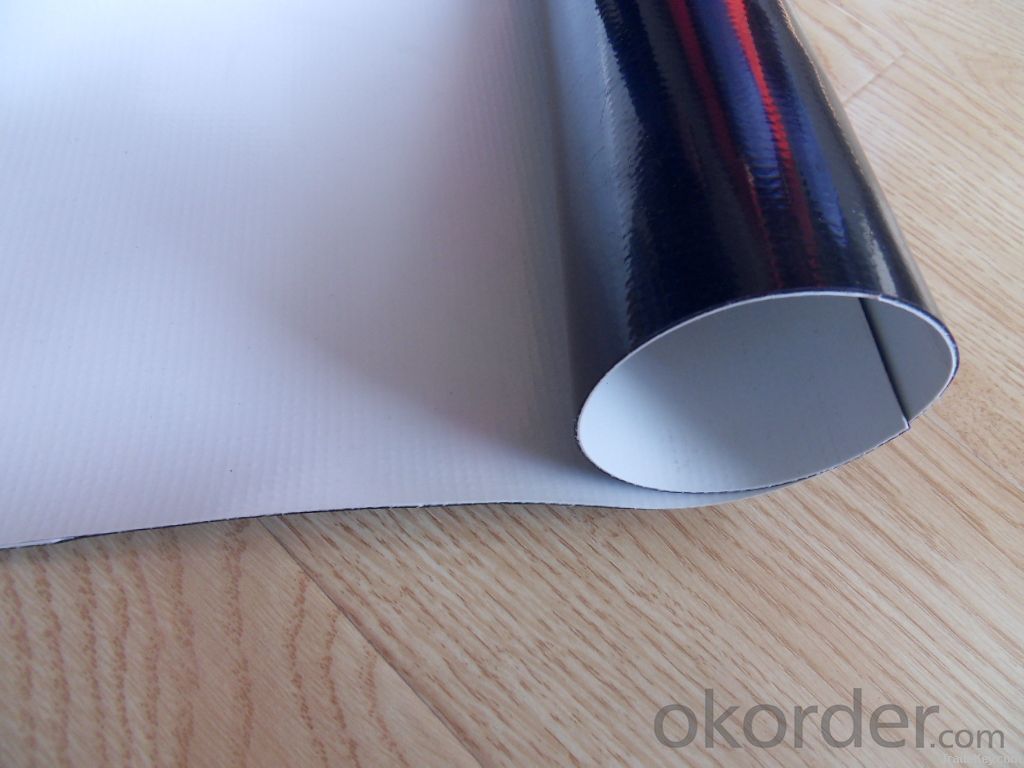
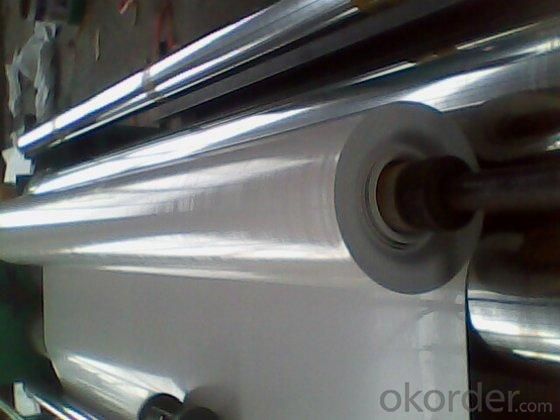

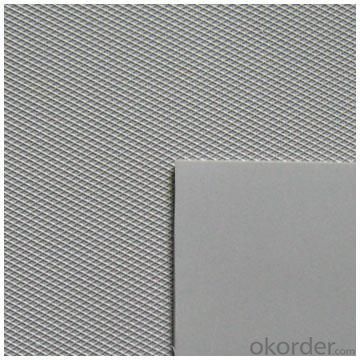
FAQ:
1. Can you produce 4m width?
Yes, no problem for us. We have four bases in China, largest one in this field.
2. How many quantity in one 20'' container for 1.2mm and 1.5mm?
480rolls, 11520m2 for 1.2mm and 400rolls, 9600m2 for 1.5mm
3. Can you provide free samples?
Yes, our samples are free, but express fees usually on buyer's account.
- Q:Are waterproofing membranes resistant to oil and fuel spills?
- Yes, waterproofing membranes are generally resistant to oil and fuel spills. These membranes are specifically designed to create a barrier that prevents water or any other liquid from penetrating through them, including oil and fuel. They are often made from materials such as polyurethane or PVC, which have excellent resistance to various chemicals, including oil and fuel. This makes them suitable for applications where there is a possibility of oil or fuel spills, such as parking garages, industrial facilities, or areas where vehicles are present. However, it is essential to note that the level of resistance may vary depending on the specific type and quality of the membrane used. Therefore, it is crucial to choose a high-quality and appropriate waterproofing membrane that meets the specific requirements of the project to ensure long-term resistance to oil and fuel spills.
- Q:Can waterproofing membranes be used for planter boxes?
- Planter boxes can indeed benefit from the use of waterproofing membranes. These membranes are specifically designed to keep water from entering surfaces and can be applied to a variety of materials like wood, concrete, and metal. When a waterproofing membrane is applied to the inside of a planter box, it acts as a shield, safeguarding the material against water damage and extending the planter box's lifespan. This is especially advantageous for wooden planter boxes because it prevents the wood from decaying or deteriorating over time. Moreover, the waterproofing membrane also aids in retaining moisture within the planter box, preventing water leakage and ensuring that plants receive an adequate water supply for healthy growth. Ultimately, the use of waterproofing membranes for planter boxes enhances their durability and performance, making them a popular choice for both indoor and outdoor gardening.
- Q:Can a waterproofing membrane be used for parking garages?
- Yes, a waterproofing membrane can be used for parking garages. A waterproofing membrane is a protective layer that is applied on surfaces to prevent water penetration. In parking garages, it is essential to have effective waterproofing to protect the structure from water damage, such as corrosion of steel reinforcement and deterioration of concrete. Parking garages are exposed to various sources of water, including rain, snow, and vehicle fluids, which can seep through cracks and joints. A waterproofing membrane acts as a barrier, preventing water from infiltrating the structure and causing damage. There are different types of waterproofing membranes available for parking garages, including sheet membranes, liquid-applied membranes, and cementitious coatings. These membranes can be applied on horizontal and vertical surfaces, such as floors, walls, and ramps, to create a watertight seal. When selecting a waterproofing membrane for a parking garage, factors such as durability, flexibility, and resistance to chemicals should be considered. The membrane should be able to withstand the heavy loads and traffic conditions typically found in parking garages. Overall, using a waterproofing membrane in parking garages is crucial to protect the structure and extend its lifespan by preventing water-related damage. It helps maintain the structural integrity and aesthetics of the garage while ensuring a safe and functional environment for users.
- Q:Can a waterproofing membrane be used in conjunction with building code requirements?
- Indeed, the application of a waterproofing membrane can be utilized alongside the mandates of the building code. The building codes commonly necessitate sufficient safeguard against moisture, particularly in regions susceptible to water seepage like basements, bathrooms, and roofs. Waterproofing membranes are deliberately crafted to establish a barrier that thwarts water infiltration, thereby bestowing an extra shield against predicaments stemming from moisture such as leaks, mold, and structural deterioration. Through the adoption of a waterproofing membrane that satisfies or surpasses the prerequisites stipulated in the building code, constructors and contractors can guarantee adherence to the regulations while simultaneously bolstering the sturdiness and durability of the edifice.
- Q:Can a waterproofing membrane be used in areas with heavy foot traffic or vehicle loadings?
- In high-traffic or heavy loading areas, it is possible to utilize a waterproofing membrane. Nevertheless, it is crucial to select a membrane specifically designed for such purposes in order to guarantee durability and longevity. These specialized membranes are typically thicker and more resistant to wear and tear. Furthermore, it is important to consider the type of traffic or loading that the area will endure. For instance, areas with vehicular traffic may necessitate a membrane with higher compressive strength to endure the weight of vehicles. In conclusion, the selection of the appropriate type of membrane that satisfies the specific demands of the application is of utmost importance when using waterproofing membranes in high-traffic or heavy loading areas.
- Q:What is the difference between a self-adhesive and torch-applied waterproofing membrane?
- A self-adhesive waterproofing membrane is a type of membrane that has an adhesive backing, allowing it to be easily stuck onto the surface it is being applied to. It is typically made of a flexible material, such as modified bitumen or rubberized asphalt, and is commonly used for applications such as roofs, balconies, or foundations. The adhesive backing ensures a strong and secure bond, even in challenging weather conditions. On the other hand, a torch-applied waterproofing membrane requires the use of a torch or heat gun to melt the underside of the membrane and adhere it to the surface. This type of membrane is often made of modified bitumen, which softens and becomes adhesive when heated. The heat creates a strong bond between the membrane and the substrate, providing excellent waterproofing protection. The main difference between these two types of waterproofing membranes lies in the way they are installed. Self-adhesive membranes offer a simpler and quicker installation process, as they can be directly applied to the surface without the need for any additional tools or equipment. They are also considered to be a safer option, as they eliminate the potential hazards associated with using an open flame. Torch-applied membranes, on the other hand, require the use of a torch or heat gun, which adds an extra step to the installation process. This method requires skilled labor and proper training to ensure the membrane is correctly melted and adhered to the surface. However, torch-applied membranes are often preferred in situations where a superior bond is required, such as on roofs with a steep slope or in areas with heavy foot traffic. In summary, the main difference between self-adhesive and torch-applied waterproofing membranes lies in the method of installation. Self-adhesive membranes offer simplicity and safety, while torch-applied membranes provide a stronger bond and are often used in more challenging or specific applications. The choice between the two ultimately depends on the specific requirements and conditions of the project.
- Q:Can a waterproofing membrane be used for elevator pits or sump pits?
- Yes, a waterproofing membrane can be used for elevator pits or sump pits. Elevator pits and sump pits are areas that are prone to water intrusion, so it is important to protect them from water damage. A waterproofing membrane is designed to create a barrier against water, preventing it from seeping into the pits and causing damage to the structure or equipment. By applying a waterproofing membrane to the walls and floors of elevator pits or sump pits, it helps to keep the area dry and free from water infiltration. This can help extend the lifespan of the elevator or sump pump system and prevent costly repairs in the future. It is important to properly install and maintain the waterproofing membrane to ensure its effectiveness and longevity.
- Q:Can a waterproofing membrane be used in steam rooms?
- Indeed, the utilization of a waterproofing membrane within steam rooms is possible. This specialized membrane is crafted to obstruct water infiltration and is commonly employed in areas where moisture is prevalent, such as bathrooms, showers, and steam rooms. The primary function of this membrane is to create a barrier that hinders water vapor from penetrating the underlying structure and inducing harm. In the case of steam rooms, where elevated levels of humidity and moisture are abundant, the implementation of a waterproofing membrane is imperative in safeguarding the walls, floors, and other surfaces from water damage and the growth of mold. It is of utmost importance to select a waterproofing membrane that is explicitly designed for environments with high moisture content, such as steam rooms, in order to ensure sufficient protection and durability. Furthermore, for the membrane to effectively fulfill its purpose within a steam room setting, proper installation and adherence to the guidelines provided by the manufacturer are essential.
- Q:Are there any specific considerations for installing a waterproofing membrane on stucco surfaces?
- Yes, there are several specific considerations to keep in mind when installing a waterproofing membrane on stucco surfaces. Firstly, it is important to ensure that the stucco surface is clean and free of any dirt, debris, or loose material before applying the waterproofing membrane. This can be done by power washing or scrubbing the surface with a stiff brush and water. Secondly, it is crucial to choose the right type of waterproofing membrane that is suitable for stucco surfaces. There are various options available in the market, such as liquid-applied membranes, sheet membranes, or peel-and-stick membranes. It is essential to select a membrane that is compatible with stucco and provides a strong and durable barrier against water penetration. Another consideration is the proper application technique. The membrane should be applied evenly and smoothly, ensuring complete coverage over the entire stucco surface. It is important to follow the manufacturer's instructions and guidelines for the specific membrane being used. Additionally, it is recommended to pay attention to the details and transitions, such as around windows, doors, vents, or other penetrations. These areas are more prone to water infiltration, so it is important to properly seal and waterproof these vulnerable points using additional techniques or products, like flashing or caulking. Furthermore, it is essential to consider the climate and weather conditions in the area. If the stucco surface is exposed to extreme temperatures or frequent freeze-thaw cycles, it is advisable to choose a waterproofing membrane that can withstand these conditions and provide long-lasting protection. Lastly, regular inspection and maintenance of the waterproofing membrane is crucial to ensure its effectiveness over time. It is recommended to periodically check for any signs of damage, such as cracking, peeling, or bubbling, and promptly address any issues to prevent water infiltration and potential damage to the stucco surface. In conclusion, when installing a waterproofing membrane on stucco surfaces, it is important to clean the surface, choose the right type of membrane, apply it correctly, pay attention to details and transitions, consider the climate, and regularly inspect and maintain the membrane for long-lasting protection against water penetration.
- Q:Are there any specific fire safety considerations for using a waterproofing membrane?
- Using a waterproofing membrane requires specific fire safety considerations. Although these membranes are designed to protect structures from water and moisture-related issues, they can also pose fire safety challenges. To begin with, it is important to evaluate the fire resistance rating of the waterproofing membrane. Building codes and regulations often mandate specific fire resistance ratings for different components of a building, such as roofing and wall systems. Therefore, it is necessary to assess the fire resistance rating of the waterproofing membrane to ensure compliance with these requirements. Moreover, the installation process of a waterproofing membrane involves the use of flammable materials like adhesives and sealants. It is crucial to choose fire-resistant materials and employ proper installation techniques to minimize the risk of fire hazards. Furthermore, the presence of a waterproofing membrane can impact the spread of fire and movement of smoke within a structure. It is essential to consider how this affects fire compartmentalization, evacuation routes, and the overall fire safety strategy of the building. Additional fire protection measures, such as fire barriers, smoke management systems, or fire-rated enclosures, may be necessary to compensate for the presence of the waterproofing membrane. Regular inspections and maintenance of the waterproofing membrane are also vital. Over time, the membrane can degrade, crack, or sustain damage, compromising its fire-resistant properties. Therefore, routine inspections and timely repairs or replacements are necessary to maintain the desired level of fire safety. In conclusion, ensuring fire safety when using a waterproofing membrane involves evaluating the fire resistance rating, using fire-resistant materials during installation, assessing the impact on fire spread and smoke movement, and implementing proper maintenance practices. These considerations are crucial for maintaining overall fire safety when utilizing a waterproofing membrane in a building.
1. Manufacturer Overview |
|
|---|---|
| Location | |
| Year Established | |
| Annual Output Value | |
| Main Markets | |
| Company Certifications | |
2. Manufacturer Certificates |
|
|---|---|
| a) Certification Name | |
| Range | |
| Reference | |
| Validity Period | |
3. Manufacturer Capability |
|
|---|---|
| a)Trade Capacity | |
| Nearest Port | |
| Export Percentage | |
| No.of Employees in Trade Department | |
| Language Spoken: | |
| b)Factory Information | |
| Factory Size: | |
| No. of Production Lines | |
| Contract Manufacturing | |
| Product Price Range | |
Send your message to us
PVC Waterproof Membrane in 0.6mm Thickness and Low Price
- Loading Port:
- Shanghai
- Payment Terms:
- TT OR LC
- Min Order Qty:
- 20000 m²
- Supply Capability:
- 5000000 m²/month
OKorder Service Pledge
OKorder Financial Service
Similar products
New products
Hot products
Related keywords
